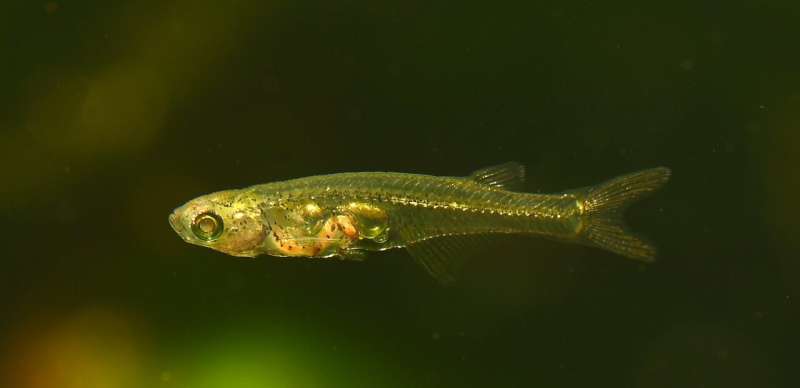This article has been reviewed according to Science X's editorial process and policies. Editors have highlighted the following attributes while ensuring the content's credibility:
fact-checked
peer-reviewed publication
trusted source
proofread
A 12 mm fish produces 140-decibel sound to communicate in turbid waters

An international research team, along with Senckenberg scientist Dr. Ralf Britz, has studied Danionella cerebrum, a small species of fish with a length of no more than 12 millimeters. Despite its diminutive size, the fish can produce sounds close to its body of over 140 decibels—comparable to a jet engine during take-off in 100 meter distance.
In their study, published in the Proceedings of the National Academy of Sciences, the researchers show that the tiny, translucent fish possess a special sound-generating apparatus. The animals presumably use the sounds to communicate with each other in turbid waters.
The snapping shrimp can generate a popping sound of up to 250 decibels with its claws. The mating calls of the flightless kakapo reach 130 decibels, and elephants can produce noise of up to 125 decibels with their trunks.
"Fishes, on the other hand, are generally considered to be rather quiet members of the animal kingdom," explains Dr. Ralf Britz of the Senckenberg Natural History Collections in Dresden. "However, there are certain fish species that can be surprisingly loud. For example, the male plainfin midshipman fish attracts its females with an audible vibrato of around 100 hertz and 130 decibels."
In their current study, Britz and an international research team led by Benjamin Judkewitz from Charité in Berlin examined the fish species Danionella cerebrum, which only reaches a length of about 12 millimeters.
"This tiny fish can produce sounds of over 140 decibels at a distance of 10 to 12 millimeters—this is comparable to the noise a human perceives of an airplane during take-off at a distance of 100 meter and quite unusual for an animal of such diminutive size. We tried to understand how the fish manages this and what mechanisms are responsible for this achievement," explains the ichthyologist from Dresden.

Using a combination of high-speed video, micro-computed tomography, gene expression analysis, and finite difference methods, the researchers show that the males of the Danionella species possess a unique sound-generating apparatus that includes drumming cartilage, a specialized rib, and a fatigue-resistant muscle.
"This apparatus accelerates the drumming cartilage with a force of over 2,000 g and shoots it against the swim bladder to produce a rapid, loud pulse. These pulses are strung together to produce calls with either bilaterally alternating or unilateral muscle contractions," adds Britz.
The permanently transparent fish, which serve as a model organism for biomedical research, are native to shallow and turbid waters in Myanmar. "We assume that the competition between the males in this visually restrictive environment contributed to the development of the special mechanism for acoustic communication," says Britz.
The study's results challenge the conventional notion that the speed of skeletal movement in vertebrates is limited by muscle movement. "Understanding the extraordinary adaptation of Danionella cerebrum expands our knowledge of animal locomotion and highlights the remarkable diversity of propulsion mechanisms in different species. This contributes to a broader understanding of evolutionary biology and biomechanics," explains the team.
"The sounds produced by other Danionella species have not yet been studied in detail; it would be interesting to learn how their mechanism of sound production differs and how these differences relate to evolutionary adaptation. In combination with its lifelong transparency, the genus Danionella offers a unique opportunity to compare the neural mechanisms underlying the sound generation between the different species."
More information: Verity A. N. O. Cook et al, Ultrafast sound production mechanism in one of the smallest vertebrates, Proceedings of the National Academy of Sciences (2024). DOI: 10.1073/pnas.2314017121
Journal information: Proceedings of the National Academy of Sciences




















